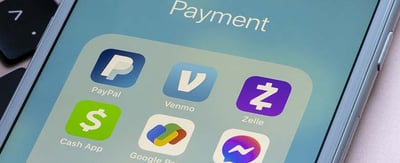
New Paradigms in Payments: Chargebacks and Digital Wallets
By Chris Alarie on Dec 8, 2021
One of side effects of the Covid-19 pandemic has been to accelerate existing payment trends. One example would be the increased use of “Buy Online, Pickup In Store” transactions. Another is the increased adoption of digital wallet payment services. According to a study conducted by eMarketer, in-store mobile payments increased by 29% in the United States last year. They forecast that over half of all U.S. smartphone users will use this method of payment by 2025.
The increased adoption of these sorts of payment methods—including Apple Pay, Google Pay, and Samsung Pay, among others—presents new opportunities for merchants. But it also brings risks, particularly regarding chargebacks.
What Are Digital Wallets?
Digital wallets are smartphone features that securely store payment information on users’ phones. This information can be used to make payments online, in-store through particular apps, or even at payment terminals through the use of near field communication (NFC) technology. Some digital wallets have P2P features, as well. Digital wallets can have other features unrelated to payment cards, including concert tickets, public transportation passes, airline tickets, etc.
As with most other forms of mobile payments, the payment features of digital wallets connect back to more traditional bank accounts. Many digital wallets serve as a way of storing and utilizing existing debit or credit cards. Some, such as Apple Pay, offer users the option to open a new payment card account specific to the digital wallet. But even those essentially function on the back end as traditional payment cards from established card brands. As a result, digital wallets are subject to the same sorts of chargeback procedures as any other payment cards.
Chargebacks and Digital Wallets
While digital wallet transactions can be subject to chargebacks just like traditional payment card transactions, that does not mean that they have the same sorts of chargeback risks. The verification system for most digital wallets conceivably lessens the risk of certain kinds of chargebacks.
Rather than a signature or PIN code, digital wallets use biometric data—usually a thumbprint or face scan—to verify the user’s identity with each purchase. This reduces the likelihood of chargebacks that arise from sources such as family fraud. It also makes it more difficult for cardholders to commit chargeback fraud by making purchases with the intention of later claiming the purchase was fraudulent. Additionally, if a cardholder does attempt to commit this sort of fraud, biometric data can be very useful as compelling evidence during representment.
Digital wallets are not immune to all sources of chargebacks, however. Chargebacks that result from some sort of consumer dissatisfaction can not be disproven through biometric data. This includes such issues as products not matching their descriptions, products not arriving when they had been promised, and products being of poor quality. The possibility of chargebacks resulting from true fraud is always a risk, as well, despite the technological efforts made by digital wallet providers to ensure security.
Another source of chargebacks that is a potential issue for digital wallets is subscription billing. Digital wallets used to pay for products or services on a subscription basis can be susceptible to such sources of chargebacks as cardholders forgetting that they had authorized subscription billing plans and unscrupulous actors taking advantage of free trial periods.
Conclusion
“Life can only be understood backwards; but it must be lived forwards.”
-- Søren Kierkegaard
“You never change things by fighting the existing reality. To change something, build a new model that makes the existing model obsolete.”
-- R. Buckminster Fuller
Digital wallets are an established and growing payment method, particularly among younger generations. Indeed, the aforementioned eMarketer study predicts that Gen Z and Millennial users will comprise more than 60% of expected new digital wallet users over the next half decade. Merchants may be understandably reluctant to accept digital wallets for a number of reasons—such as the technological costs of installing a NFC reader—but it is likely to be an unavoidable form of payment in the near future.
While digital wallets offer both advantages and disadvantages with regards to chargebacks, most of the disadvantages are tied to practices entirely under the control of the merchant, such as shoddy merchandise or confusing subscription billing procedures. A well run business should allow merchants to take advantage of the benefits of accepting digital wallets for payment while reducing their susceptibility to the detrimental aspects of that payment method.


